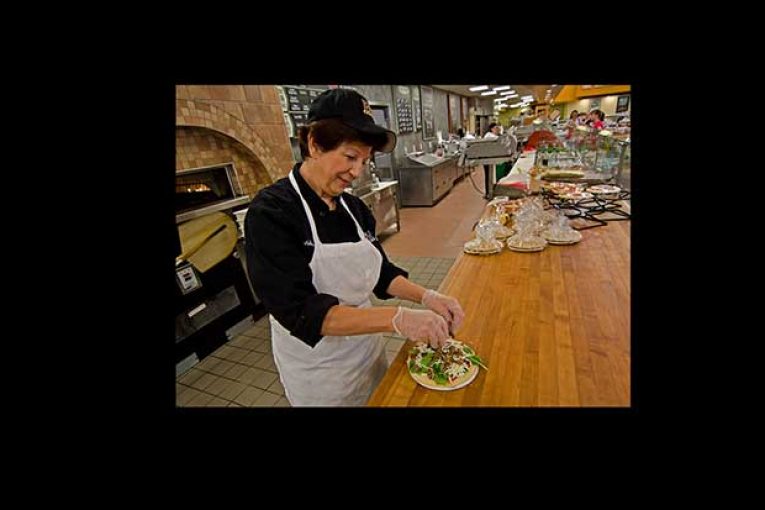Fresh Meal Solutions In Supermarkets—The Train Has Left The Station

by Harry Blazer/Food industry consultant and former grocer
I founded and ran Harry’s Farmers Market in Atlanta, and I helped run Dekalb Farmers Market before that.
We were not just retailers at Harry’s. We ran the highest compliance USDA prepared foods commissary in the country at the time (the late 1980s and early ’90s), with scores up to 99.7 percent. At the commissary, we manufactured hundreds of prepared food items every day from scratch for our retail stores. And when I say “from scratch,” I mean using only the highest quality primary ingredients I could find or ingredients made from primary ingredients—i.e., fully disclosed, one-word ingredient statements. We introduced true artisan bakery items produced on a large scale to the supermarket industry, again made from scratch. And by “scratch,” I mean water and flour, not mixes. In fact, we made our own baking powder.

We were the first retailer to be HAACP certified under the Department of Commerce so we could put a “Grade A” on our seafood in our stores. I invented the first chain of neighborhood fresh convenience stores (Harry’s in a Hurry) that featured produce, specialty groceries and prepared foods in all three categories—ready-to-heat, ready-to-eat, ready-to-cook—all of which was either made in-plant or finished in store from components made in-plant.
When the company was sold to Whole Foods Market in 2001, our manufacturing infrastructure was used to propel that chain’s expansion into the Southeast, and is still used today. And my team has helped H-E-B, Loblaw, Coles and Morrisons, among others, to achieve new levels of excellence in fresh and prepared foods.
Why am I telling you this? So you will listen. So you will understand that I have seen a lot, done a lot and have been an innovator in this industry since 1979—and have the victories along with the bruises and scars to prove it.
What’s wrong, from my perspective
Why are supermarkets in general not good at executing fresh meal solutions? Take a look at what most supermarkets have to offer in their ready-to-eat hot deli. Rotisserie or fried chicken, maybe some fried shrimp, maybe some ribs, and a few sides, usually a variation on a potato (often fried) and occasionally a vegetable or two that is not a potato. Almost always, these components are made by industrial producers with long lists of ingredients with a lot of weird names, contain a bunch of sugar and salt (and until recently trans fats) and often are filled with GMOs.
Compare those offerings with just about any quick-service restaurant in a similar category, and supermarkets have less variety, poorer quality (hot deli food has often been sitting around and is well past its prime when served), much longer wait times, are harder to access by car, are served by folks who are under-trained and under-motivated and an offering that represents not as good a value for calories provided (I didn’t say nutrition). And a typical Costco sells 20 times the rotisserie chickens that an average supermarket does, generally in better condition and for less money for comparable weight.
The ready-to-eat cold deli is nearly indistinguishable within most major chains. And more and more customers are tired of waiting for mediocre service and in turn are purchasing self-serve packaged deli instead.
How about ready-to-heat? Do most supermarkets have anything that can compare in value and appeal to Costco’s ready-to-heat items that it offers in its meat department in most of its stores? How did a chain of warehouse club stores that started as a non-food retailer figure out how to be a better provider of ready-to-heat meal solutions for the family than supermarkets?
And ready-to-cook items? Maybe you can find a few uninspired prepackaged offerings in the self-serve meat or seafood department and sometimes in the meat and seafood service case if there is one. But otherwise, you need to visit the frozen case or aseptically packaged offerings from industrial manufacturers.
At one time, food retailers actually had momentum as innovators in meal solutions compared to foodservice providers. But this has not been the case for well over two decades. Maybe that is why the foodservice industry has surpassed the supermarket industry in dollars spent for food.
There are certainly some success stories, with Wegmans, Whole Foods Market and H-E-B (the big three) and at times The Fresh Market and Publix and, of course, Trader Joe’s, which is really in a category by itself. And there are always a few independents that shine through.
But even with the “big three” that I named, which often have made large investments in infrastructure and personnel, the best food being served in those stores is almost always from something that resembles a restaurant—a QSR clone that does subs or pizza, a sitdown kiosk where you can get a broiled piece of fish and some freshly made sides, a sushi stand or a real restaurant that is within or attached to a store. In each case, it’s where food is close to or actually being prepared to order. Not a hot bar, not a prepared food case, not even a salad bar.
But even many offerings from these companies don’t meet my standards for ingredient integrity and high value—the nexus of price, quality and experience.
Look overseas for some inspiration
Have you been to the U.K.? For 40 years, the U.K. supermarket industry has been showing the world the power of fresh meal solutions. There are whole stores and food halls devoted to prepackaged, commissary-produced, meal solutions that offer huge variety and much higher quality than we offer in this country. Some stores sell thousands of commissary-made, fresh sandwiches a day. And there is a large, sophisticated manufacturing infrastructure to support that just-in-time fresh, prepared, meal-solution industry. Yes, home refrigerators are smaller, frozen food offering is not as robust and people shop more often in the U.K. But as a result, the solutions are there for the world to see.
I had to build a prepared food facility back when I was in business because there were no manufacturers in the country who came close to providing the solutions I wanted. And I had to grow staff internally—including management—because there was no one with experience doing packaged, restaurant-quality offerings made fresh every day from scratch to scale at that time. Now there are many more manufacturers in this game to draw on in this country and Canada.
Time to make meal solutions a priority
So let me give you the bad news. Almost none of you have had anyone with vision, passion, knowledge and commitment driving these programs in your company, and if you did, you did not support them sufficiently. You have, for the most part, relied on “solutions” that have been provided by the larger industrial food producers and distributors, so you have very little differentiation or authenticity. You have focused on costs vs. innovation and have tried to get way too high margins for the quality you have provided. You visited Wegmans, H-E-B, Whole Foods or Stew Leonard’s and tried to implement a watered-down version that you poorly understood and didn’t have the culture to sustain. You have a model that has way too much labor for sales compared to the QSR industry. You have a model that can’t deliver quality food at a decent price. You have employees in these areas who are undertrained, underpaid, under-incented and under-motivated. You have squandered an opportunity.
You now have to contend with Amazon, which can deliver the world to the doors of most of the urban population in the U.S. (and increasingly the world) within a few hours and in a day to most of the rest of the country—at a price that works. It delivers groceries, the stuff that takes up most of your floor space. It is hard for anyone to compete with a company that has its cost of capital, consumer appeal, expertise in technology, talent base, culture, penchant for and success at innovation and is the largest data/server infrastructure provider for the intelligence agencies and for many online businesses, which as a core competency provides many hundreds of millions in cash flow that it can use to fund its food experiments. Not to mention that it possesses the most sophisticated and arguably lowest cost logistics network in North America. And now, they will also deliver within an hour, through Amazon Restaurant, one’s choice of prepared-to-order meal solutions from some of the best local restaurants in an increasing number of urban areas. And a host of others are doing the same.
That just made the best brains and innovators in the food industry—creative, authentic, hard working, neighborhood restaurateurs using high quality, local and credentialed ingredients with a good story to tell—available to eventually all urban dwellers within an hour of wanting it, without having to get in their car. Why should anyone go to your stores for meal occasion solutions any longer?
You need to figure out an answer to this because the world is changing in a way that is giving folks fewer and fewer reasons to come to your stores. Especially with lower cost providers like Aldi and Lidl coming around the corner selling some groceries, specialty groceries, perishables and meal solutions for much better value. And who, by the way, over the last half-decade have totally changed the food retailing landscape in the U.K.